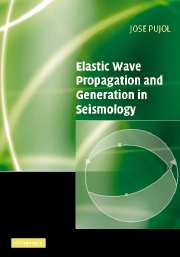Book contents
- Frontmatter
- Contents
- Preface
- Acknowledgements
- 1 Introduction to tensors and dyadics
- 2 Deformation. Strain and rotation tensors
- 3 The stress tensor
- 4 Linear elasticity – the elastic wave equation
- 5 Scalar and elastic waves in unbounded media
- 6 Plane waves in simple models with plane boundaries
- 7 Surface waves in simple models – dispersive waves
- 8 Ray theory
- 9 Seismic point sources in unbounded homogeneous media
- 10 The earthquake source in unbounded media
- 11 Anelastic attenuation
- Hints
- Appendices
- Bibliography
- Index
8 - Ray theory
Published online by Cambridge University Press: 12 November 2009
- Frontmatter
- Contents
- Preface
- Acknowledgements
- 1 Introduction to tensors and dyadics
- 2 Deformation. Strain and rotation tensors
- 3 The stress tensor
- 4 Linear elasticity – the elastic wave equation
- 5 Scalar and elastic waves in unbounded media
- 6 Plane waves in simple models with plane boundaries
- 7 Surface waves in simple models – dispersive waves
- 8 Ray theory
- 9 Seismic point sources in unbounded homogeneous media
- 10 The earthquake source in unbounded media
- 11 Anelastic attenuation
- Hints
- Appendices
- Bibliography
- Index
Summary
Introduction
The elastic wave equation admits exact solutions in relatively few cases involving simple variations in elastic properties. When these properties vary in a two- or three-dimensional way, the equation cannot be solved exactly and either numerical (e.g., finite-difference, finite-element) or approximate solutions must be sought. Ray theory is one of the possible approaches introduced to solve the equation approximately. This theory is traditionally associated with optics, where it originated (for reviews see, e.g., Kline and Kay, 1965; Cornbleet, 1983; Stavroudis, 1972). The extension of the theory to the propagation of electromagnetic waves is due to Luneburg (1964) (work done in the 1940s) while the application to elastic waves is due to Karal and Keller (1959), although simpler ray-theoretic concepts had been used earlier (Cerveny et al., 1977). Russian authors also contributed to the solution of the elastic problem (see, e.g., Cerveny and Ravindra, 1971).
Over the last three decades elastic wave ray theory has grown enormously in scope and complexity and for this reason in this chapter only the most fundamental aspects will be discussed. Two important topics not addressed here are numerical solutions to the ray equations and the considerably more difficult problem of computing amplitudes. The former is well treated by Lee and Stewart (1981), and the latter by Cerveny (2001), who present a thorough discussion of ray theory and includes an extensive reference list.
- Type
- Chapter
- Information
- Elastic Wave Propagation and Generation in Seismology , pp. 234 - 277Publisher: Cambridge University PressPrint publication year: 2003



